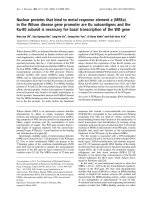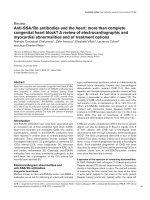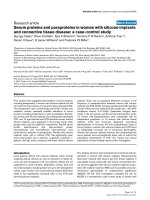Báo cáo y học: " Renal cell carcinoma metastasis to the ciliary body responds to proton beam radiotherapy: a case report" pptx
Bạn đang xem bản rút gọn của tài liệu. Xem và tải ngay bản đầy đủ của tài liệu tại đây (4.98 MB, 5 trang )
JOURNAL OF MEDICAL
CASE REPORTS
Renal cell carcinoma metastasis to the ciliary
body responds to proton beam radiotherapy: a
case report
Alasil et al.
Alasil et al. Journal of Medical Case Reports 2011, 5:345
(3 August 2011)
CAS E REP O R T Open Access
Renal cell carcinoma metastasis to the ciliary
body responds to proton beam radiotherapy:
a case report
Tarek Alasil
*
, Bahram Khazai, Lilia Loredo and Michael E Rauser
Abstract
Introduction: We report an unexpected presentation of metastatic renal cell carcinoma (RCC) to the ciliary body
and an interesting response to proton beam radiotherapy.
Case presentation: We encountered a case of angle-closure glauc oma as the initial presentation of ocular
metastasis to the ciliary body in a 65-year-old Caucasian man who had undergone right radical nephrectomy for
RCC 15 years earlier. He underwent YAG (yttrium aluminium garnet) laser peripheral iridotomy while further
metastatic workup took place. His condition was eventually diagnosed as stage IV metastatic RCC of the clear cell
type and involved multiple sites, including the ciliary body, brain, lungs, liver, and pancreas. The progression of RCC
metastasis to the ciliary body was studied for 16 months. The ciliary body mass continued to grow despite
systemic treatment with temsirolimus and interleukin-2 and intravitreal injections of bevacizumab. The tumor size
peaked at 6.11 × 6.06 mm before the start of proton therapy, which reduced the tumor size to 5.07 × 4.39 mm.
Conclusions: RCC can produce metastases involving unusual sites many years after resection of the primary tumor.
Proton therapy was found to be effective in treating RCC metastasis to the ciliary body in settings in which other
treatment modalities failed.
Introduction
Renal cell carcinoma (RCC) accounts for approximately
85% of primary renal neoplasms and repr esents approxi-
mately 3% of all adult malignancy [1]. The most com-
mon sites of metastasis are the lung ( 50%) and the bone
(33%), but RCC has been documented to metastasize to
every organ and site in the body by hematogeno us
spread. The interval between RCC systemic and ocular
presentations varies and may become so prolonged as to
obscure the relationship between the ocular metastasis
and the primary RCC tumor [2]. In a pathologic survey ,
FerryandFont[3]demonstratedthatonlysevenoutof
196 cases of ocular metastat ic carcinoma originated
from RCCs. Ocular metastases from RCC are most
likely to involve the iris [4], ciliary body [5], and chor-
oids, although eyelid and orbital metastases have been
described [6].
We report a rare case of angle-closure glaucoma sec-
ondary to ciliary body metastasis in a patient who
underwent radical nephrectomy for RCC 15 years ear-
lier. Also, we review the different treatment modalities
we used to treat the ocular metastasis.
Case presentation
A 65-year-old Caucasian man presented to our emer-
gency department and complained of sudden-onset
blurry vision and pain in his right eye. He reported asso-
ciated nausea and a right-sided headache. His medical
history was significant for RCC, for which he had under-
gone right ra dical nephrectomy 15 years earlier. After
the initial nephrectomy, he had completed 10 years of
surveillance, after which he was thought to be disease-
free.
At presentation, his best corrected visual acuities were
20/50 in his right eye (oculus dexter, or OD) and 20/20
in his left eye ( oculus sinister,orOS).Theintraocular
pressures by applanation tonom etry were 50 mm Hg
OD and 14 mm Hg OS. The results of a left eye exam
* Correspondence:
Department of Ophthalmology, Loma Linda University, Loma Linda, CA
92354, USA
Alasil et al. Journal of Medical Case Reports 2011, 5:345
/>JOURNAL OF MEDICAL
CASE REPORTS
© 2011 Alasil et al ; license e BioMed Central Ltd. Th is is an Open Access article distributed under the terms of the Creative Commons
Attribution License (http://creativecommons .org/licenses/by/2.0), which permits unrestricted use, distribution, and reproduction in
any medium, provid ed the original work is properly cited.
were unremarkable. A slit-lamp exam of his right eye
demonstrated a red mass that was l oca ted in the super-
ior nasal aspect of his iris at one to three o’clock and
that was associated with dilated episcleral feeder vessels
(Figure 1a). A gonioscopy showed a closed angle with
the iris bowing forward to the superior nasal sector of
the anterior chamber angle. A high-frequency immer-
sion B-scan ultrasonography of his right eye revealed a
ciliary body mass, which was pushing his iris forward
toward his cornea (Figure 2a). An iris angiography of his
right eye showed an area of hyperfluorescence over the
area of his tumor (Figure 1b). A fundus examination of
his right eye showed no evid ence of c horoidal or retinal
involvement.
His condition was diagn osed as acute a ngle-closure
glaucoma (AACG) secondary to a ciliary body mass in
his right eye. He was started on timolol, acetazolmide,
and latanoprost followed by a YAG (yttrium aluminium
garnet) laser peripheral iridotomy to lower the intraocu-
lar pressure.
The results of a further metastatic workup were con-
sistent with a stage IV RCC that w as of the clear cell
type (Figure 3) and that involved the ciliary body, brain,
lungs, liver, and pancreas.
The ciliary body mass continued to grow despite sys-
temic treatment with temsirolimus (mammalian target of
rapamycin inhibitor) [7] and interleukin-2 (IL-2) (Figure
1c), but the extraocular metastasis started to shrink. Later,
a
c
e
d
b
Figure 1 (a) Slit-lamp exam (S LE) photograph of the right eye at presentation shows a red mass in the superior nasal aspect of the
iris at one to three o’clock. (b) Iris angiography of the right eye shows an area of hyperfluorescence over the area of the tumor. (c) SLE
photograph of the right eye 10 months later (status after systemic treatment with temsirolimus and interleukin-2 and intravitreal injections of
bevacizumab) shows that the red mass had grown. (d) SLE photograph delineates the mass-lens adhesions prior to proton beam radiotherapy.
(e) SLE photograph of the right eye after proton radiotherapy shows a significant decrease in the size of the mass.
Alasil et al. Journal of Medical Case Reports 2011, 5:345
/>Page 2 of 4
two intravitreal injections of bevacizumab failed to slow
the growth of the mass, and the tumor size peaked at 6.11
× 6.06 mm (Figure 2a). Some adhesions have developed
between the mass and the lens (Figure 1d).
Lastly, proton radiotherapy was administered. Tanta-
lum clips were placed to outl ine the posterior margin of
the tumor. Our patient received a total of 30 cobalt gray
equivalents (CGE) in three fractions given over the
course of six calendar days. As a result, the tumor size
decreased to 5.07 × 4.39 mm (Figures 1e and 2b). Later,
our patient underwent an uneven tful cataract extraction
and an intraocular lens placement in his right eye. His
current visual acuity in his right eye is 20/40.
Discussion
The mechanism of ocular spread in RCC is presumed to
take place through venous dif fusion within the small
chroidal vessels, and neoplastic cells travel as emboli [8].
Simultaneous bilateral iris metastases from RCC were
described by Wizinski and colleagues [4]. Two cases of
spontaneous disappearance of choroidal metastasis from
RCC after nephrectomy have been described [9,10].
Shome and colleagues [11] reported a case of iris metas-
tasis from RCC 14 months after a right nephrectomy.
Mancini and colleagues [8] reported a case of left ciliary
body metastasis in a 42-year-old man who had under-
gone a left r adical nephrectomy for conventional RCC
six years earlier. Our patient is unusual because, before
he presented with AACG, he was thought to be disease-
free for 15 years after nephrectomy but he was even-
tually discovered to have widespread RCC metastasis.
Although the extraocular metastasis showed a reason-
able response to systemic temsirolimus and IL-2, the
ciliary body metastasis failed to do so. One theory may
question the bioavailability of these systemic agents in
the ciliary body circulation system.
Primary RCC produces angiogenic growth factors
(such as basic fibroblastic growth factor and vascular
endothelial growth factor), which are responsible for
tumor growth, proliferation, metastases, and survival
through high serum levels [12]. Unfortunately, our
ab
Figure 2 (a) High-frequency immersion B-scan ultrasonography of the right eye reveals the ciliary body mass at a peak size of 6.11 ×
6.06 mm. (b) B-scan ultrasonography after proton radiotherapy reveals the regression of the ciliary body mass size to 5.07 × 4.39 mm.
Figure 3 Histopathologic image of optically clear cytoplasm,
sharply outlined cell membranes, round to irregular nuclei,
and prominent nucleoli. Pathology findings are consistent with
clear cell carcinoma, Fuhrman grade III (renal cell carcinoma
metastasis).
Alasil et al. Journal of Medical Case Reports 2011, 5:345
/>Page 3 of 4
patient’s tumor continued to grow despite intravitreal
injections of bev acizumab (anti-vascular endothelial
growth factor).
The prognosis of metastatic RCC is generally poor;
median survival is 10 months and five-ye ar survival is
less than 5% [13,14]. Our patient has survived for 16
months with an extraocular response to the syst emic
temsirolimus and IL-2. His affected eye maintained
visual acuity and the ciliary body mass regressed in
response to the proton radiotherapy f ollowed by suc-
cessful cataract surgery.
Several urologists advocated RCC surveillance for at
least 10 years after the initial nephrectomy . Others con-
cluded that follow-up for life is reasonable [15-20]. Our
case report would emphasize such extended surveillance
as long as it is individualized and cost-conscious.
Conclusions
We present an interventional case report in which the
progression of RCC metastasis to the ciliary body was
studied for 16 months. The response to differe nt treat-
ment modalities was investigated. The ciliary body mass
continued to grow despite systemic treatment with tem-
sirolimus and IL-2 and intravitreal injections of bevaci-
zumab. The tumor size peaked at 6.11 × 6.06 mm
before the start of proton therapy, which reduced the
tumor size to 5.07 × 4.39 mm. To the best of our
knowledge, this is the first case report of a ciliary body
metastasis from RCC that responded to proton radio-
therapy after other treatment modalities had failed.
Consent
Written informed consent was obtained from the patient
for publication of this case report and a ny accompany-
ing images. A copy of the written consent is available
for review by the Editor-in-Chief of this journal.
Abbreviations
AACG: acute angle-closure glaucoma; IL-2: interleukin-2; OD: oculus dexter
(right eye); OS: oculus sinister (left eye); RCC: renal cell carcinoma.
Authors’ contributions
TA analyzed and interpre ted the patient data and wrote the manuscript. BK
helped to gather the data and write the manuscript. LL was the radiation
oncologist who treated our patient with proton beam radiotherapy. MER
was the attending ophthalmologist who evaluated our patient, performed
the bevacizumab intravitreal injections, and coordinated the proton beam
radiotherapy. All authors have read and approved the final manuscript.
Competing interests
The authors declare that they have no competing interests.
Received: 4 January 2011 Accepted: 3 August 2011
Published: 3 August 2011
References
1. Garnick MB, Richie JP: Primary neoplasms of the kidney and renal pelvis.
In Disease of the Kidney. Volume 1 5 edition. Edited by: Schrier RW,
Gottschalk CW. Boston: Little, Brown; 1993.
2. Haimovici R, Gragoudas ES, Gregor Z, Pesavento RD, Mieler WF, Duker JS:
Choroidal metastases from renal cell carcinoma. Ophtalmol 1997,
104:1152-1158.
3. Ferry AP, Font RL: Carcinoma metastatic to eye and orbit: a
clinicopathologic study of 27 cases. Ophtalmol 1974, 92:276-286.
4. Wizinski P, Rootman J, Wood W: Simultaneous bilateral iris metastases
from renal cell carcinoma. Am J Optalmol 1981, 92:206-209.
5. Laszczyk WA: Metastatic tumor of the ciliary body-hypernephroma.
Ophtalmologica 1975, 170:543-547.
6. Kindermann WR, Shields JA, Eiferman RA: Metastatic renal cell carcinoma
to the eye and adnexae: a report of three cases and review of the
literature. Ophthalmol 1981, 88:1347-1350.
7. Kapoor A, Figlin RA: Targeted inhibition of mammalian target of
rapamycin for the treatment of advanced renal cell carcinoma. Cancer
2009, 115:3618-3630.
8. Mancini V, Battaglia M, Lucarelli G, Di Lorenzo V, Ditonno P, Bettocchi C,
Selvaggi FP: Unusual solitary metastasis of the ciliary body in renal cell
carcinoma. Int J Urol 2008, 15:363-365.
9. Langmann G, Mullner K: Spontaneous regression of choroidal metastasis
from renal cell carcinoma. Br J Opthalmol 1994, 78:883.
10. Hammad AM, Paris GR, van Heuven WAJ, Thompson IM, Fitzsimmons TD:
Spontaneous regression of choroidal metastasis from renal cell
carcinoma. Am J Ophthalmol 2003, 135:911-913.
11. Shome D, Honavar SG, Gupta P, Vemuganti GK, Reddy PV: Metastasis to
the eye and orbit from renal cell carcinoma: a report of three cases and
review of literature. Surv Ophthalmol 2007, 52:213-223, Review.
12. Dosquet C, Coudert MC, Lepage E, Cabane J, Richard F: Are angiogenic
factors, cytokines, and soluble adhesion molecules prognostic factors in
patients with renal cell carcinoma. Clin Cancer Res 1997, 3(12 Pt
1):2451-2458.
13. Motzer RJ, Mazumdar M, Bacik J, Berg W, Amsterdam A, Ferrara J: Survival
and prognostic stratification of 670 patients with advanced renal cell
carcinoma. J Clin Oncol 1999, 17:2530-2540.
14. Clement JM, McDermott DF: The high-dose aldesleukin (IL-2) “select” trial:
a trial designed to prospectively validate predictive models of response
to high-dose IL-2 treatment in patients with metastatic renal cell
carcinoma. Clin Genitourin Cancer 2009, 7:E7-E9.
15. Abara E, Chivulescu L, Clerk N, Cano P, Goth A:
Recurrent renal cell cancer:
10 years or more after nephrectomy. Can Urol Assoc J 2010, 4:E45-E49.
16. Montie JE: Follow-up after partial and total nephrectomy for renal cell
carcinoma. Urol Clin North Am 1994, 21:589-592.
17. Hafez KS, Novick AC, Campbell SC: Patterns of tumour recurrence and
guidelines for follow-up after nephron-sparing surgery for sporadic renal
cell carcinoma. J Urol 1997, 157:2067-2070.
18. Ljungberg B, Alamdari FI, Rasmuson T, Roos G: Follow-up guidelines for
non-metastatic renal cell carcinoma based on the occurrence of
metastases after radical nephrectomy. BJU Int 1999, 84:405-411.
19. Stephenson AJ, Chetner MP, Rourke K, Gleave ME, Signaevsky M, Palmer B,
Kuan J, Brock GB, Tanguay S: Guidelines for the surveillance of localized
renal cell carcinoma based on the patterns of relapse after
nephrectomy. J Urol 2004, 172:58-62.
20. Ljungberg B, Hanbury DC, Kuczyk MA, Merseburger AS, Mulders PF,
Patard JJ, Sinescu IC, European Association of Urology Guideline Group for
renal cell carcinoma: Renal cell carcinoma guideline. Eur Uro 2007,
51:1502-1510.
doi:10.1186/1752-1947-5-345
Cite this article as: Alasil et al.: Renal cell carcinoma metastasis to the
ciliary body responds to proton beam radiotherapy: a case report.
Journal of Medical Case Reports 2011 5:345.
Alasil et al. Journal of Medical Case Reports 2011, 5:345
/>Page 4 of 4









